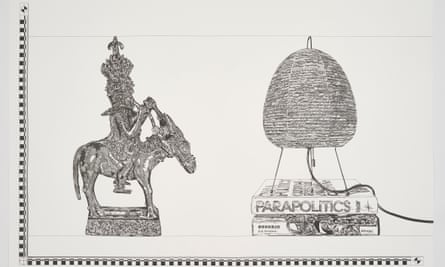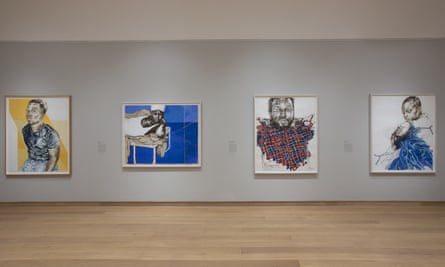
Jasleen Kaur’s red Ford Escort, standing in the gallery and covered by a giant cotton doily, its sound system blasting out snatches of pop and hip-hop and qawwali devotional song will surely be the laugh-out-loud totemic image of this year’s Turner prize show at Tate Britain. It is but one of several arresting moments, in a show filled with cultural collisions, shifts in register and wildly divergent intentions. Business as usual, then.
It’s raining ink. It’s erupting in hearts and skulls and human faces, and in a menagerie of human hares, tree-people and coral in Delaine Le Bas’s labyrinthine installation. Blood-red footprints cross the gallery floor. A can-can of naked legs, a bulbous paper dragonfly, a galumphing sad-sack horse fashioned from organdie stuffed with hay and feathers are among the profusion of ideas and images. Figures loom in hanging, translucent cotton tents and there are mythological and magical signs and portents everywhere in Le Bas’s work.

I haven’t a clue what all the furniture and embroidery and the nature symbolism means (I’m pretty immune to that sort of thing) but Le Bas’s installation, recreating her 2023 show at Secession in Vienna, is full of vitality and surprise, witches and devils, silliness and verve. What Le Bas calls her “Gypsy-hippy-punk” aesthetic, and her Roma-Traveller background are the motors of her art.
All artists have a story to tell and in this year’s Turner prize tales of origin and arrival are crucial. Pio Abad’s childhood in Manila, the family home being sprayed with machine-gunfire by supporters of the Marcos regime, are part of his origin story. Jasleen Kaur’s memories of visiting the hardware shops and cash’n’carry warehouses in Glasgow where her father worked, and the syncretic values of her Sikh background, are embedded in her art.

Bottles of Irn-Bru float above our heads, along with bits of hi-vis clothing, scarves and tangles of hair, Scottish pound notes and lottery tickets, Nusrat Fateh Ali Khan CDs and glow-in-the-dark prayer beads. They litter a translucent canopy hanging over an enormous Axminster carpet that sweeps into the distance, begging that we sit and look and listen, as though we were adrift in the day.
But there’s so much going on here that lingering feels impossible. Bells tinkle on wooden fingers, and the breathy wheeze of a mechanically operated harmonium accompanies the artist’s voice, which drifts out of nowhere, rising and falling in song. I like all this very much. And what of the photographs on the floor, of Sikhs and Muslims praying together, and a protesting crowd surrounding an immigration enforcement van on a Glasgow street? Kaur’s work is filled with texture and humour and complexity. And there’s that bloody car again, sound-system blasting.
A gigantic, concrete version of a 30-carat ruby and diamond pearl bracelet – part of the $21m (£15.7m) hoard of jewellery that Imelda and Ferdinand Marcos stole from the Filipino people and which was discovered hidden in the nappies of the kleptocrat’s grandchildren when they fled into exile in Hawaii in 1986 – sits on a low plinth in Pio Abad’s installation. It is one of the many re-workings of this obscene haul that Abad, along with his wife, jewellery designer Frances Wadsworth Jones, is engaged in making as a long-term project.
Abad’s Turner exhibition reconfigures his recent, historiographic, museological display at the Ashmolean in Oxford, which delved into Oxford’s museum collections – principally the collections of the Ashmolean and the Pitt-Rivers museum – to tell stories of colonialism and theft. You really have to attend to Abad’s own wall labels to discover what’s going on – here is a 1692 etching advertising a young, tattooed Filipino who was enslaved in 1687 and bought to England as a living curiosity and who then died of smallpox, part of his skin displayed in Oxford’s Bodleian Library.
Abad has made a series of laser engravings on marble, based on this earlier etching, depicting an arm and outstretched hand, grasping at nothing, or at life itself. This is one of several telling, beautiful and painful works here, which also examine the 19th-century theft of the Benin bronzes from the Edo Kingdom (in what is now Nigeria), and the fate of what is estimated as 90% of Philippine material heritage, which, it is estimated, now resides in western museums. You really need hours in Abad’s installation to unravel the complexities and iniquities. His rigour is manifest, and his art needs a lot of unpacking.
after newsletter promotion

All four contenders have, by and large, re-created versions of the exhibitions they were nominated for by this year’s judges. Kaur re-shows works from a recent exhibition at Tramway, Glasgow, while Claudette Johnson presents many of the same large pastel portraits that were shown earlier this year at the Courtauld in London. Johnson’s portraits, in pastel and oil stick and gouache loom on the walls. She’s in there, too, caught looking, as though uncertain of her own scrutiny. They are at once tender and gravelly, wary and cautious and sympathetic. I wish I liked them more.
Somehow, all the effort of her approach gets in the way. It feels as if she always has to do a lot to get over her chosen medium’s inertia, and her compositions feel a bit staid. For me, the energy is elsewhere. Jasleen Kaur is where it’s at.
 Print
Print


